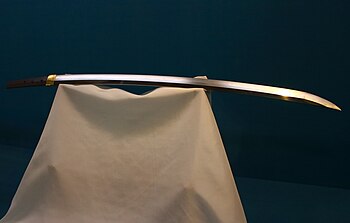
Back كاتانا Arabic Katana AST Katana Azerbaijani Катана Byelorussian Катана BE-X-OLD Катана Bulgarian কাতানা Bengali/Bangla Katana Breton Katana BS Катана BXR
| Katana (日本刀) | |
|---|---|
 A katana modified from a tachi forged by Motoshige. Bizen Osafune school influenced by the Sōshū school. 14th century, Nanboku-chō period. Important Cultural Property. Tokyo National Museum | |
| Type | Sword |
| Place of origin | Japan |
| Service history | |
| Used by | Samurai, onna-musha, ninja, kunoichi, kenjutsuka, iaijutsuka, iaidoka, and battōjutsuka |
| Production history | |
| Produced | Nanboku-chō period (1336–1392) which corresponds to the early Muromachi period (1336–1573)[1] to present |
| Specifications | |
| Mass | approx. 1.1–1.5 kg (2.4–3.3 lb) |
| Blade length | approx. 60–80 cm (24–31 in) |
| Blade type | Curved, single-edged |
| Hilt type | Two-handed swept, with circular or squared guard |
| Scabbard/sheath | Lacquered wood, some are covered with fish skin, decorated with brass and copper.[2][3] |
A katana (刀, かたな, lit. 'one-sided blade') is a Japanese sabre characterized by a curved, single-edged blade with a circular or squared guard and long grip to accommodate two hands. Developed later than the tachi, it was used by samurai in feudal Japan and worn with the edge facing upward. Since the Muromachi period, many old tachi were cut from the root and shortened, and the blade at the root was crushed and converted into a katana.[4] The specific term for katana in Japan is uchigatana (打刀, うちがたな, lit. 'striking sword') and the term katana (刀) often refers to single-edged swords from around the world.[5]
- ^ Cite error: The named reference
en20p43was invoked but never defined (see the help page). - ^ Cite error: The named reference
takeotwas invoked but never defined (see the help page). - ^ "日本の技術の精巧さは…". Mainichi Shimbun. 27 March 2016. Archived from the original on 28 August 2016.
- ^ Cite error: The named reference
suriagewas invoked but never defined (see the help page). - ^ 日本刀と刀の違い Nagoya Japanese Sword Museum Touken World